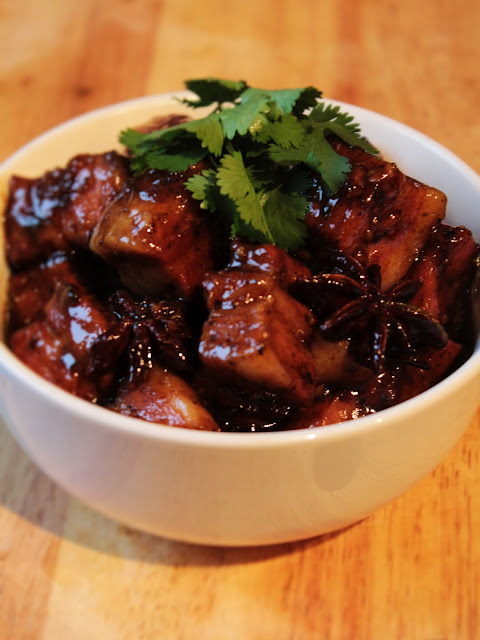I've been looking forward to making this sticky, sweet braised pork dish for a while now and it did not disappoint. Moo Hong belongs to a family of similar Chinese influenced, dark coloured stews that also includes khao kha moo (stewed pork leg) and moo paloe (pork braised with eggs). They all share some common ingredients: soy sauce, star anise, long cooking time and fatty cuts of pork but it's down to the consistency and what they're served with that makes for some subtle differences.
Moo Hong uses large chunks of belly pork and is cooked down until you're left with a rich, peppery, sweet and sticky sauce and meat that is soft and unctuous. Although it needs just over an hour to cook it's very easy to make.

For two large portions use:
- 400g of pork belly, rind removed and cut into inch square pieces. Try to find a piece that is fairly even in thickness and has a good meat/fat ratio
- half a bulb garlic, peeled
- a dessert spoon of black peppercorns
- a small handful of coriander roots or stalks (roots seem impossible to find in the UK)
- a golf ball size chunk of palm (or light brown) sugar
- 3 star anise
- a big splash of oyster sauce
- a big splash of light soy sauce
- a big splash of dark sweet soy sauce (I use Indonesian kecap manis)
- 2-3 cups of water (you may need a bit more)
- small splash of oil for frying
Make a well blended paste by bashing the black pepper, palm sugar, garlic and coriander in a mortar; by adding the harder ingredients first and adding the softer ones last you should end up with a fairly smooth paste.
Heat a splash of vegetable oil in a deep pan until medium hot. Carefully add in the cubed pork belly and fry for 3-4 minutes until some of the fat has rendered out and the pork is lightly browned. Pour off the excess fat from the pan (there'll be plenty in the dish as the pork cooks down).
Pop in the spice paste and stir well for a moment or two; the sugar in the paste will make the pork sticky but be careful not to let it sit and burn.
Pour hot water over to just cover the pork then add in the rest of the ingredients (sauces and star anise). The sauce will be dark but very thin. Pop on a lid and lower the heat to a gentle simmer, let the pork reduce and cook down for around 75-90 minutes. Check it and stir gently every now and again, making sure there's still enough liquid; top up with a little water if need be.
The final sauce should be thick and sticky (of a honey- like consistency). Serve with freshly cooked rice and some extra coriander.










